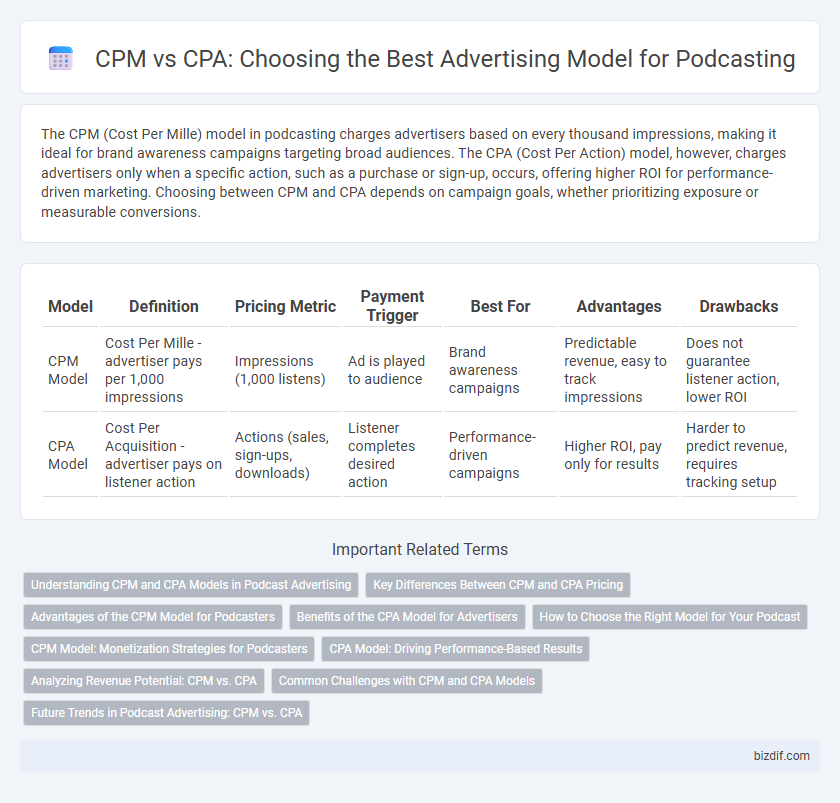The CPM (Cost Per Mille) model in podcasting charges advertisers based on every thousand impressions, making it ideal for brand awareness campaigns targeting broad audiences. The CPA (Cost Per Action) model, however, charges advertisers only when a specific action, such as a purchase or sign-up, occurs, offering higher ROI for performance-driven marketing. Choosing between CPM and CPA depends on campaign goals, whether prioritizing exposure or measurable conversions.
Table of Comparison
| Model | Definition | Pricing Metric | Payment Trigger | Best For | Advantages | Drawbacks |
|---|---|---|---|---|---|---|
| CPM Model | Cost Per Mille - advertiser pays per 1,000 impressions | Impressions (1,000 listens) | Ad is played to audience | Brand awareness campaigns | Predictable revenue, easy to track impressions | Does not guarantee listener action, lower ROI |
| CPA Model | Cost Per Acquisition - advertiser pays on listener action | Actions (sales, sign-ups, downloads) | Listener completes desired action | Performance-driven campaigns | Higher ROI, pay only for results | Harder to predict revenue, requires tracking setup |
Understanding CPM and CPA Models in Podcast Advertising
The CPM (Cost Per Mille) model in podcast advertising charges advertisers based on every thousand ad impressions, making it ideal for brand awareness campaigns targeting broad audiences. The CPA (Cost Per Acquisition) model bills advertisers only when a specific action, such as a sale or lead, is completed, optimizing ROI for performance-driven campaigns. Marketers selecting between CPM and CPA must assess campaign goals, audience engagement, and conversion tracking capabilities to maximize advertising effectiveness.
Key Differences Between CPM and CPA Pricing
The CPM (Cost Per Mille) model charges advertisers based on every 1,000 podcast impressions, emphasizing audience reach and brand exposure, while the CPA (Cost Per Action) model bills only when a specific action, such as a listener purchase or signup, occurs, prioritizing measurable conversions. CPM pricing benefits podcasters with large, engaged audiences, enabling predictable revenue through ad impressions regardless of immediate listener response. CPA pricing appeals to performance-driven advertisers seeking direct returns on investment by paying solely for verified listener actions, making it ideal for campaigns targeting sales or lead generation.
Advantages of the CPM Model for Podcasters
The CPM (Cost Per Mille) model offers podcasters predictable revenue by paying based on every thousand ad impressions, ensuring consistent income regardless of listener actions. This model simplifies campaign management and reduces risk, as advertisers invest upfront without depending on conversion tracking. Podcasters benefit from higher fill rates and the ability to monetize traffic effectively even with lower listener engagement.
Benefits of the CPA Model for Advertisers
The CPA model offers advertisers precise cost control by charging only for actual conversions, maximizing return on investment and reducing wasted ad spend common in traditional CPM campaigns. This performance-based approach enhances tracking accuracy and attribution, enabling data-driven optimization tailored to podcast audience engagement. Advertisers benefit from higher campaign efficiency and improved budget allocation, directly linking expenditure to measurable sales or leads.
How to Choose the Right Model for Your Podcast
Choosing the right monetization model for your podcast depends on your audience engagement and revenue goals. The CPM model offers predictable earnings based on ad impressions, ideal for podcasts with high download volumes and consistent listenership. The CPA model suits performance-driven campaigns, rewarding podcasters for specific actions like conversions, making it effective for niche audiences focused on targeted marketing outcomes.
CPM Model: Monetization Strategies for Podcasters
The CPM (Cost Per Mille) model offers podcasters a reliable revenue stream by charging advertisers based on every thousand listens or impressions, enabling predictable income with scale. This model aligns well with brand awareness campaigns where advertisers seek broad exposure, making it ideal for podcasts with high listener counts and consistent engagement. Podcasters can optimize CPM earnings by targeting niche audiences, enhancing episode quality, and leveraging dynamic ad insertion to maximize advertiser value.
CPA Model: Driving Performance-Based Results
The CPA model in podcast advertising prioritizes cost-efficiency by charging advertisers only for specific actions such as conversions or leads generated, ensuring measurable performance-based results. This model aligns podcast ad spend directly with audience engagement and campaign goals, enhancing accountability and ROI for advertisers. Podcasters leveraging CPA frameworks can attract brands seeking transparent, outcome-driven partnerships that maximize marketing impact.
Analyzing Revenue Potential: CPM vs. CPA
CPM (Cost Per Mille) model generates revenue based on every thousand ad impressions, offering consistent income for podcasters regardless of user actions. CPA (Cost Per Acquisition) model rewards podcasters for specific listener actions like purchases or sign-ups, potentially yielding higher earnings if the audience is highly engaged. Analyzing revenue potential depends on audience size, engagement levels, and the ability to drive conversions, where CPM suits large, broad audiences and CPA excels with targeted, action-driven campaigns.
Common Challenges with CPM and CPA Models
CPM (Cost Per Mille) models in podcasting often face challenges such as difficulty in measuring true listener engagement and potential ad wastage due to impressions counted without guaranteed actions. CPA (Cost Per Action) models, while performance-driven, struggle with attribution complexities and delayed conversions, making it harder to directly link podcast ads to specific listener actions. Both models require sophisticated tracking and analytics to optimize ad spend and demonstrate clear ROI in the dynamic podcast advertising landscape.
Future Trends in Podcast Advertising: CPM vs. CPA
The future of podcast advertising is shifting as brands increasingly evaluate CPM (Cost Per Mille) versus CPA (Cost Per Action) models for ROI optimization. CPM remains effective for broad audience reach and brand awareness, while CPA is gaining traction with performance-driven campaigns that demand measurable user actions like downloads or subscriptions. Advances in analytics and attribution technology will further empower advertisers to choose models that maximize engagement and conversion within targeted podcast demographics.
CPM Model vs CPA Model Infographic

 bizdif.com
bizdif.com